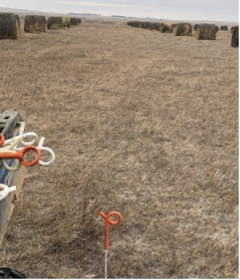Join our Mailing list!
Get all latest news & be the first to know about upcoming events.
It’s not cost-effective to haul bales in from the field in the summer, just to turn around and haul them back to the herd through the snow in the winter. A better idea: strategically place them in the field with temporary fences and bring the cows to them to “bale graze” in the winter. No need any more to start the tractor up on cold winter days!
Bart Carmichael, who ranches near Faith, South Dakota, says running a tractor in the winter is more costly than you might think. “We’re keeping hours off our tractor. Tractor depreciation when you run a tractor is something like $150 to $200 an hour. So even depreciation is real money; the hours add up.”

So Carmichael sets fence posts and electric wire around sets of bales in the fall instead. “A lot of times in the wintertime, I just run out there with the four wheeler and roll up a fence and let the cows move to new bales,” he says.
Harold Gaugler, who runs cattle in Grant County, North Dakota, and Thunder Hawk, South Dakota, has been bale grazing in the winter for more than 10 years. Gaugler started by grazing bales on top of the hills where his hay fields were degraded, with the intent to build better soils. He says it’s worked– he gets more hay production with this practice. “I think we get almost a third more hay production now than we had before. It’s probably because of the increased nitrogen from the manure and the urine that’s out there from bale grazing in the winter. Another part of it is the amount of moisture that you can save out there.”
Get more top bale grazing advice from this video (14 minutes).
 Source: This article is courtesy of Growing Resilience Through our Soils
Source: This article is courtesy of Growing Resilience Through our Soils
Get all latest news & be the first to know about upcoming events.